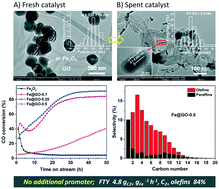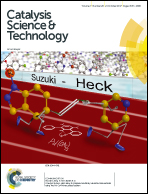Two-dimensional graphene-directed formation of cylindrical iron carbide nanocapsules for Fischer–Tropsch synthesis†
Abstract
Iron-based Fischer–Tropsch synthesis provides a promising alternative as a direct and non-petroleum route for producing olefins from syngas (CO + H2). In general, a promoter is required to regulate the activity and olefin selectivity, and the major challenges come from catalyst deactivation due to carbon deposition and sintering under drastic reaction conditions (340 °C, high pressure). In this study, we show a totally different strategy for solving these problems. We find that the originally large spherical Fe2O3 particles of around 120 nm assisted by graphene without an additional promoter can gradually evolve during the FTS reaction, forming much smaller cylindrical Hägg carbide nanocapsules of about 10 nm with a single (510) crystal facet, that display excellent activity nearly 40 times that of the unmodified one, olefin selectivity of 76% (84% if methane is not considered) and high stability. In contrast, the original Fe2O3 catalyst and carbon-containing polymer material (e.g. PAA, PVP)-modified Fe2O3 catalysts exhibit significantly lower selectivity for olefins and higher selectivity for methane and deactivate rapidly. Different from the above-mentioned peculiar evolution of iron particles, the iron particles over these spent catalysts aggregate into larger ones having multiple crystal facets, e.g. χ-Fe5C2 (510), and χ-Fe5C2 (−202), and at the same time serious carbon deposition is observed, which mainly accounts for catalyst deactivation. In the case of activated carbon and carbon nanofiber supported iron catalysts with initially small iron particles below 10 nm, irregular morphology and multiple crystal facets of iron carbides are also observed over the spent catalysts. DFT calculations demonstrate that the χ-Fe5C2 (510) crystal facet is more active and favorable for the formation of olefins than the χ-Fe5C2 (−202) crystal facet, which is well in accordance with our experimental results. The presented methodology provides a new strategy to control the morphology and crystal facet of iron carbide during the catalytic reaction for solving the toughest problems in heterogeneous catalysis.



 Please wait while we load your content...
Please wait while we load your content...